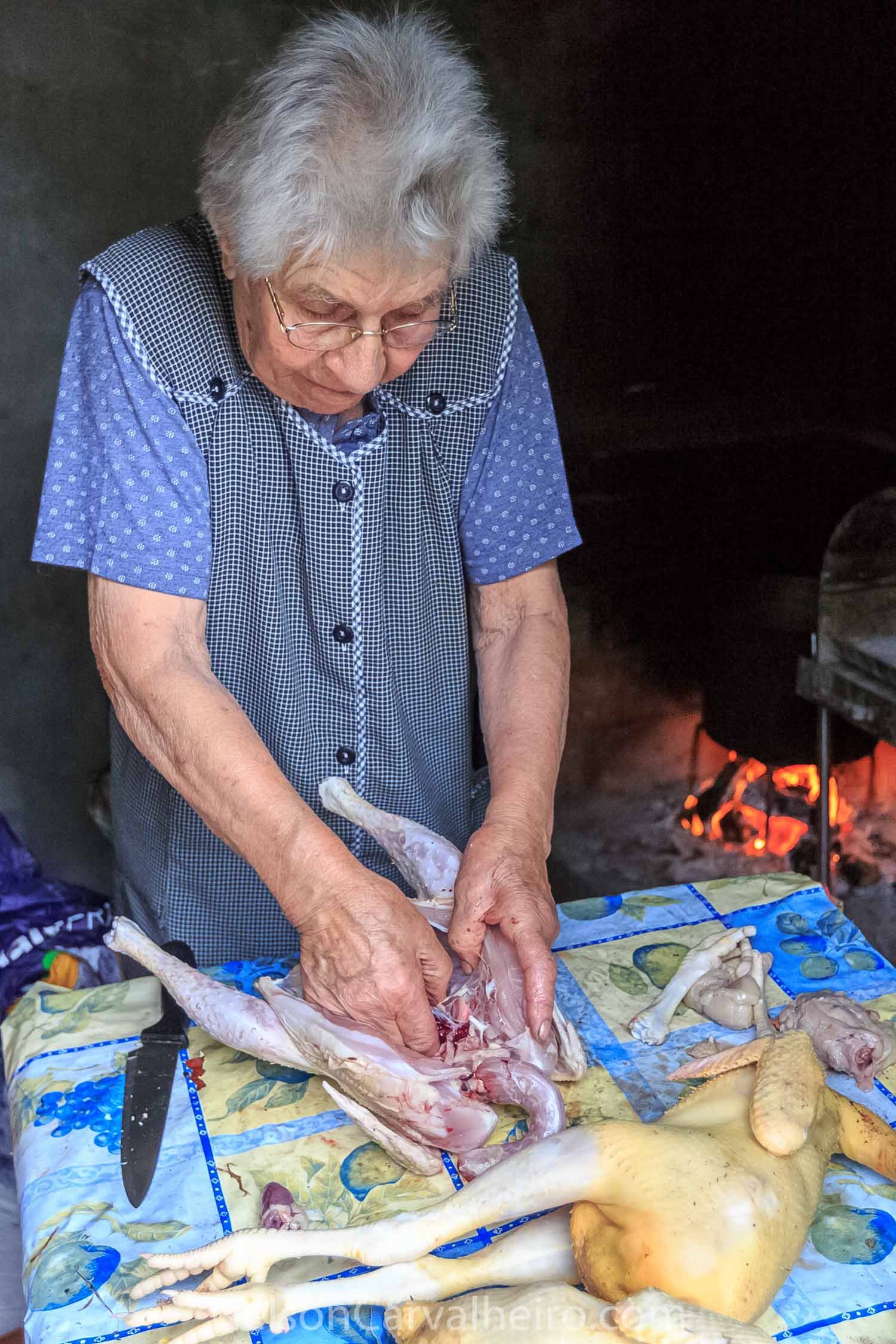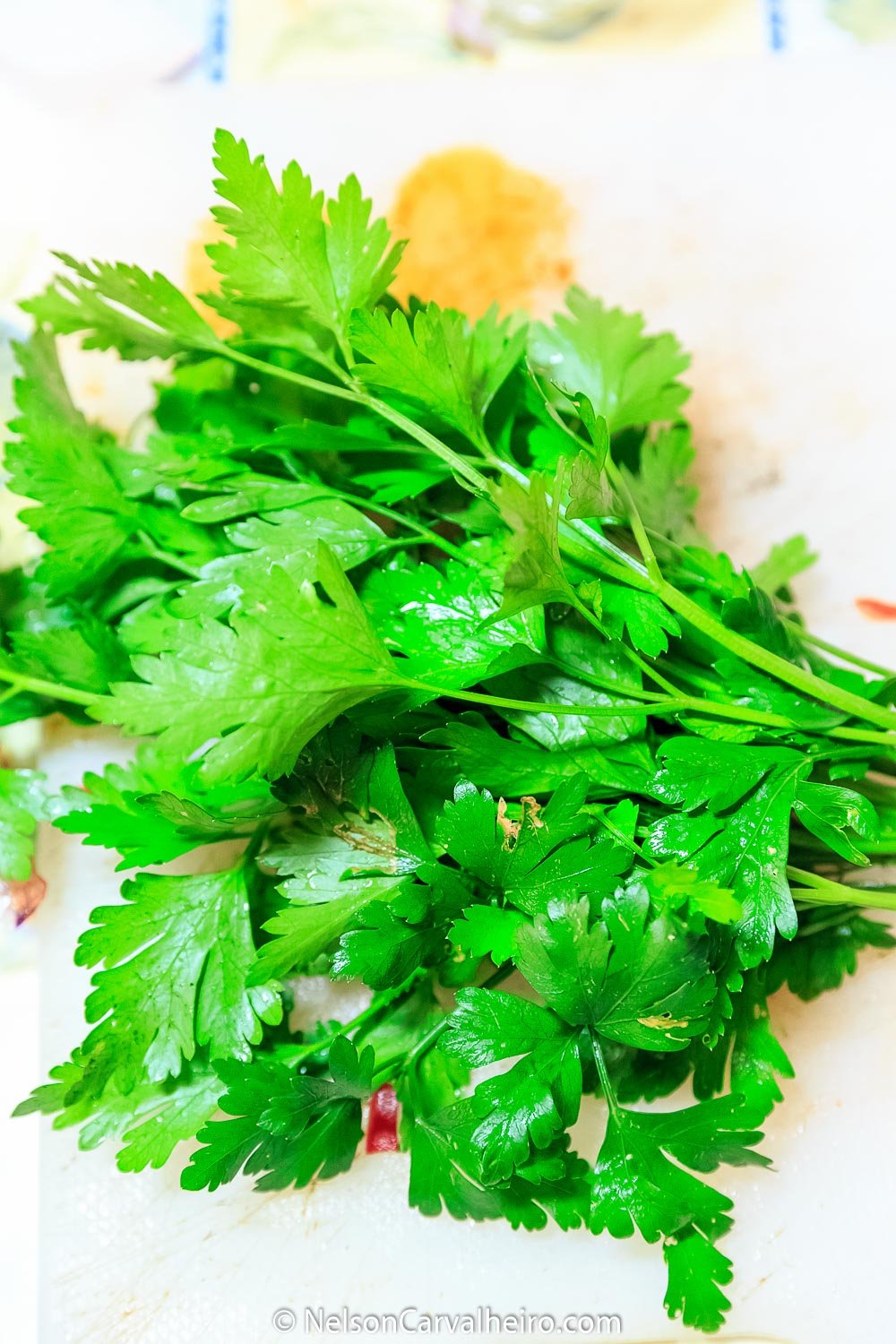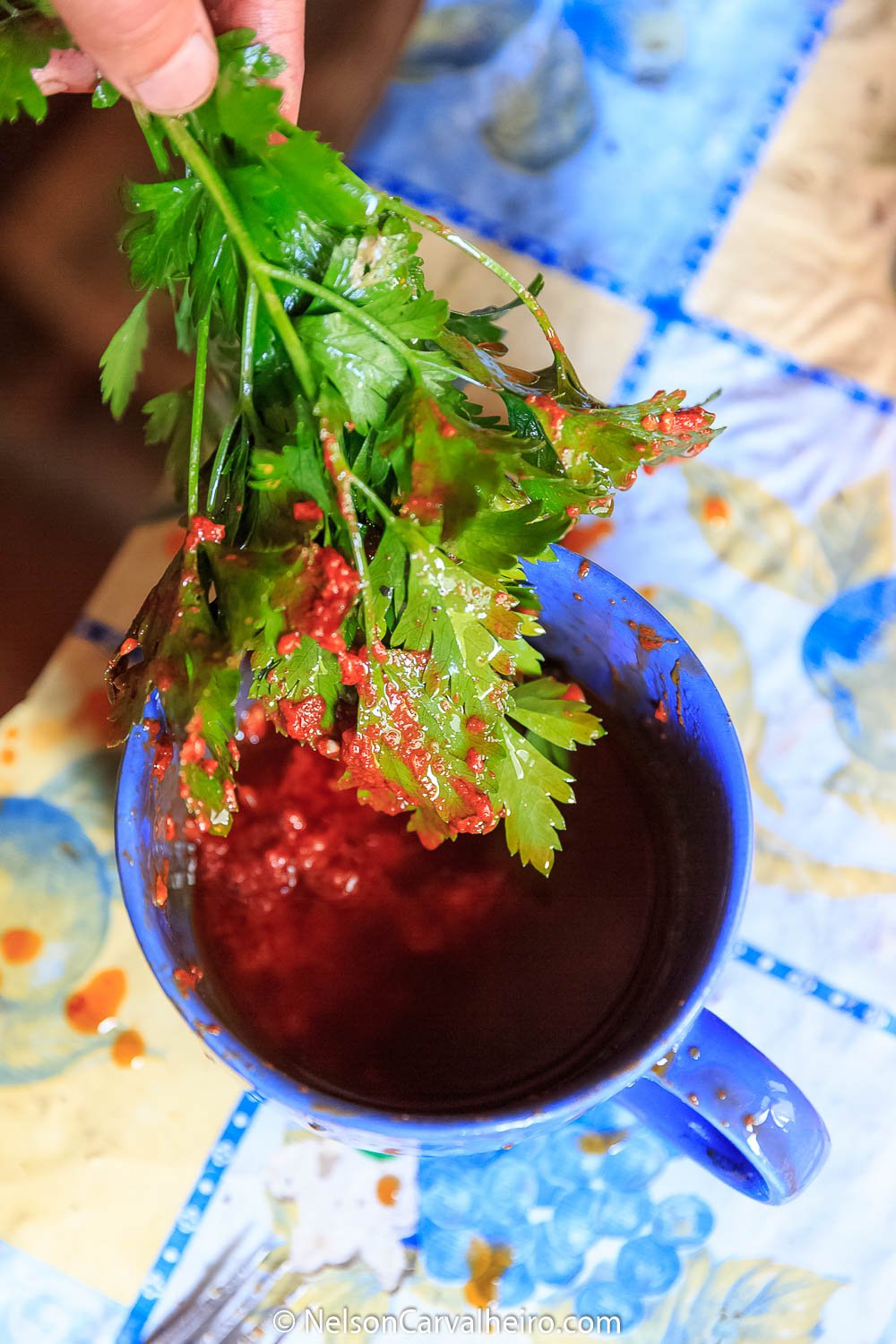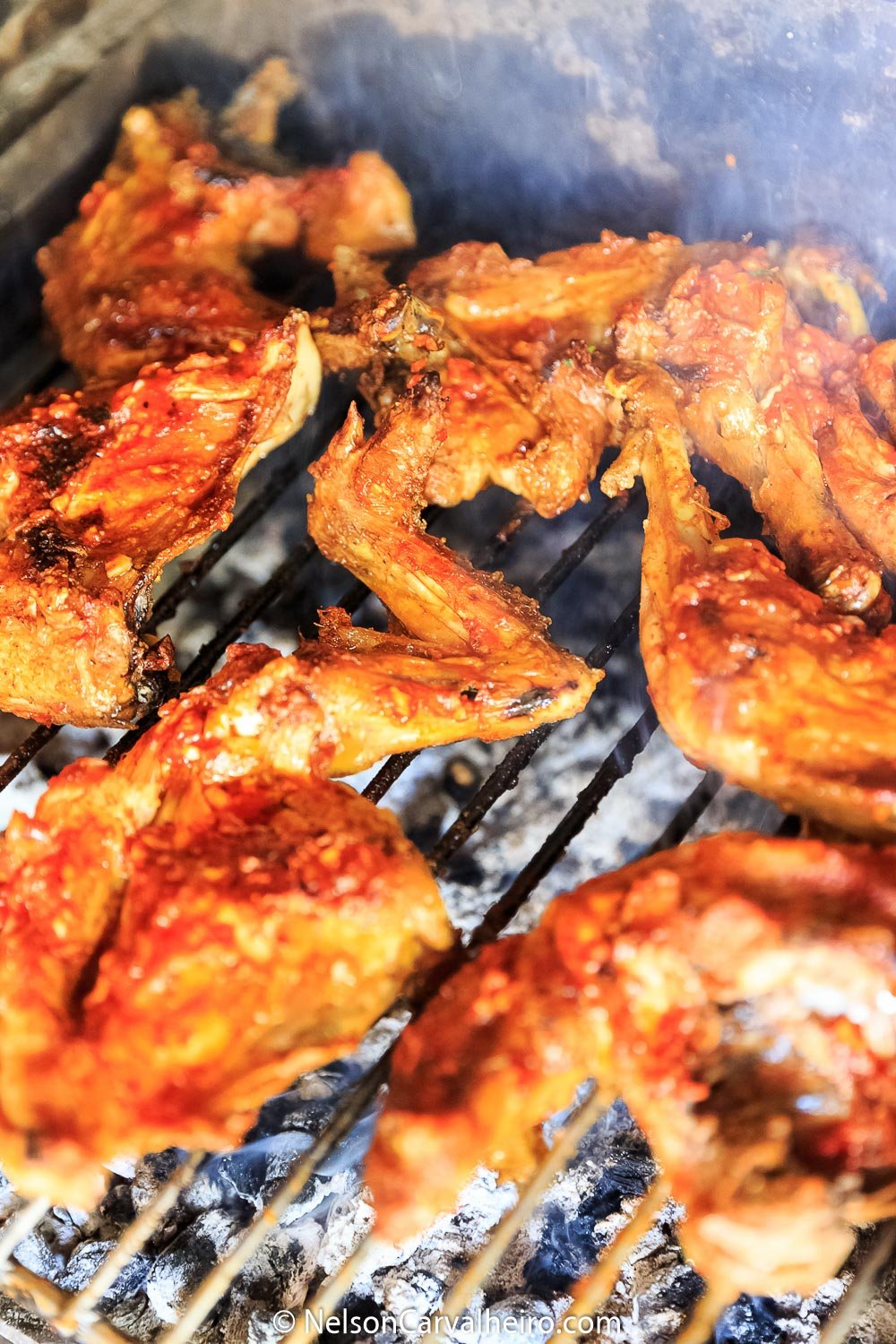My grandmother’s Portuguese Piri Piri Chicken Recipe will add some authentic Portuguese fiery flavour to your Sunday lunch. It’s finger licking good, and a great way to bring all the family together. Believe me, we have done it for over 50 years. All courtesy of Maria de Jesus (Mary of Jesus) my grandmother from my father’s side, and the woman behind my undisputed love for food, for Traditional Portuguese Food.
 Growing up in a self-sustaining own production farm in the Center of Portugal, we grew almost everything we ate. The fertility of the soil in our lands assured that all fruits and vegetables grew without needing fertilizers or any kind odd additives. The same goes for the livestock we had, and that my grandmother cared for in such a dear motherly way. Chickens, pigs, ducks, rabbits, geese and the occasional pheasant were fed from we had planted according to the season. We were raised not to trust the produce that was sold in the shops, and the only time we bought things for the house was during the Sunday trip to the Marinha das Ondas farmer’s market.
Growing up in a self-sustaining own production farm in the Center of Portugal, we grew almost everything we ate. The fertility of the soil in our lands assured that all fruits and vegetables grew without needing fertilizers or any kind odd additives. The same goes for the livestock we had, and that my grandmother cared for in such a dear motherly way. Chickens, pigs, ducks, rabbits, geese and the occasional pheasant were fed from we had planted according to the season. We were raised not to trust the produce that was sold in the shops, and the only time we bought things for the house was during the Sunday trip to the Marinha das Ondas farmer’s market.

Every Sunday my grandmother would get up early as if it was a normal workday. Taking the little doggies with her, she would head over to the chicken hut. “You and you…Come with me” she said to the two roosters whose fate had been written the moment they were born on the Carvalheiro farm. Without any fear of the desperate wing flapping or even the constant bite attempts, she grabs both birds by the feet I will spare you the details, but soon after, the chickens were ready for the charcoal grill.
What I am trying to say, my grandmother’s Portuguese Piri Piri Chicken Recipe does not work if you are using mass-produced poultry. Neither if you use anything other than organic produce. Also, if you are in a rush and are looking for a “30 min pop it in the over Piri Piri Chicken”, this recipe is not for you. However, if you have time and respect for the institution of Food, then please read onwards.
Get a fat, free range chicken
I cannot stress enough how important it is to use a free-range, corn and vegetable fed chicken. There is no substitute for the happiness the bird had from eating all those yummy vegetable and roaming freely in the open fields. Supermarket chickens are filled with chemicals and have water injected into them. They are not just going to taste bland, they are bad for your health.
 Charcoal Grilling takes time
Charcoal Grilling takes time
No Portuguese Piri Piri chicken recipe can be made without using charcoal to grill the chicken. We have been grilling Piri Piri Chicken since we introduced the world to chillies from central America in the 15th century. Any other recipe that requires frying, braising or oven roasting is a fake. The chicken is supposed to the grilled in whole so it takes time of the heat released by the charcoal to render the fat and penetrate the skin. I am fully aware that not all of you have a balcony or even a barbecue, let alone the time. But believe me, it will pay off in every single level if you take the time to do it.
 Don’t add unnecessary ingredients
Don’t add unnecessary ingredients
This recipe keeps faithful to its Portuguese origins. It does not take chilies in powder, dry or flake form. Neither lemon, oregano, peppers, caster sugar, coriander or ginger. It does not need food processors or any other fancy kitchen equipment. Just keep it simple and the natural flavour of the meat the chillies do their work. Also, this is not a Mexican dish and certainly doesn’t need one, let alone two salsas Mr. Jamie Oliver. Have some respect, please!
Piri Piri Sauce
The Piri Piri sauce for the chicken is different from the Piri Piri Oil recipe, as it is the heat from the charcoal and the hot chicken which will release the flavours of the ingredients.
 What is the secret of this Portuguese Piri Piri chicken recipe
What is the secret of this Portuguese Piri Piri chicken recipe
Unlike other recipes, my grandmother’s Portuguese Piri Piri Chicken does not require overnight marinades. It is the last minute basting of the Piri Piri sauce we just made, which is going to give the flavour to the meat. Because the sauce has garlic, it should only be added when the chicken is almost done or else you will get that burnt garlic bitter taste. Also, the slow roasting over the charcoal will promote the slow release of the bone marrow juices into the chicken meat contributing the final overall flavour. So, make a Sunday family feast of this recipe and don’t forget to eat the chicken with your hands, the way it was meant to be eaten.
Portuguese Piri Piri Chicken Recipe Ingredients
- 1 large free-range chicken (about 1.5 kg) split in half
- rough Sea Salt
For the Piri Piri Sauce
- 100 ml of extra virgin olive oil
- 10 garlic cloves (crushed)
- 3 fresh red chillies (diced) (put more if you wish it to be spicier)
- 3 large bay leaves
- Teaspoon of paprika
- Large bunch of parsley (to be used as brush)
Portuguese Piri Piri Chicken Recipe Preparation
For the Chicken:
Let the chicken rest on the counter for at least 30/40 min so the meat reaches room temperature. Half it – you can also chop it into 4 large pieces – legs + thighs, breast, and wings, but never take anything off the bone. Season the chicken with salt and make the Piri Piri Sauce.

 Piri Piri Sauce Preparation
Piri Piri Sauce Preparation
Add the olive oil, crushed garlic, chillies, paprika and bay leaves to bowl. Wisk so all the ingredients are evenly spread. Let it rest for a bit while the chicken roasts.

 Grilling the chicken
Grilling the chicken
Fire up the barbecue using only charcoal from a wood origin, not coal from the mines. Also never use a petroleum-based igniter, as you will end up with the chicken tasting of paint thinner. Only add the chicken when the embers are over their peak heat and are starting to go grey on the outside.
 Start with the skin side up on the edge of the grill so you don’t burn the skin. Let the chicken cook. Don’t mess with it. Don’t flip it back and forth. Just let it go. When you can see a nice golden brown colour on the edge of the skin, gently slide the spatula or thongs under and turn it over. Remember to keep the chicken high above the burning coal so that any flames from the dripping fat don’t burn the skin. Be sure to put out any flare-ups immediately. Allow about 15 to 20 minutes for each side of the chicken, depending on how young (tender) the meat is.
Start with the skin side up on the edge of the grill so you don’t burn the skin. Let the chicken cook. Don’t mess with it. Don’t flip it back and forth. Just let it go. When you can see a nice golden brown colour on the edge of the skin, gently slide the spatula or thongs under and turn it over. Remember to keep the chicken high above the burning coal so that any flames from the dripping fat don’t burn the skin. Be sure to put out any flare-ups immediately. Allow about 15 to 20 minutes for each side of the chicken, depending on how young (tender) the meat is.

When you notice the meat starting to peel off the bone, it means the chicken is almost ready. Dip the bunch of parsley into the Piri Piri Sauce and baste generously on the dry chicken skin. Keep basting for about 5 minutes depending on the size and thickness of the chicken.
Then give it one last grill on the skin side to crispen it up.
EAT IMMEDIATELY!
Disclaimer:
I would like to thank Benerent and their CEO Nuno Luz for their outstanding car rental services every time I am in Portugal and allowing me to travel the country to tell these candid Portuguese Food Stories.
Go to Benerent.com or call +351 262 925 190 for a quote.
Related Posts
60 Comments
Add comment Cancel reply
This site uses Akismet to reduce spam. Learn how your comment data is processed.







oh wow that looks amazing. Totally agree with you on the chicken we always buy free range organic in England but have to say even then the chicken is no where near as good as the Portuguese chicken we have purchased.
I am so happy that you have this good experience in Portugal. thanks for sharing!
I had this when I visited Portugal last year. And I must say it was very good. I will try to make this myself. Wish me luck.
and wash it down with madronja lovely jubbly bang! as good as scrumpy cider wow. I lost my legs in Lagos
Hi Nelson,
I wanted to ask how the bay leaves are incorporated into the sauce. Are they just left whole to add flavor to the other ingredients as they marry, or is actually broken up and incorporated into the sauce?
Hello Freddie,
The bayleaves are just there to add the flavour. They should be discarded afterwards. 🙂
Hi Nelson, I was a bit anctious to get my sauce ready and I chopped up the bayleaves. I will let you know what happens to the chicken.
Chickens are omnivores and free range chickens will happily eat worms, insect, fly larvae… even vermin.
Your recipe and chicken preparation looked delicious, but the genuinely authentic piri piri sauce has been “bastardized” by every recipe claiming to be the original! I am 70 and was raised in Rhodesia and ate chicken piri piri from a young age because it was “invented” in our next door neighbor country of Mozambique.
Portugal sent chilies to its two African colonies of Angola and Mozambique about 200 years ago because it could not find a commercial use for them, and it was in the town of Beira (Mozambique) in the late 1890s that an elderly lady managed to produce this pinnacle of salivating sauces. She only used two ingredients (3 if you include a little water), but ingeniously created a taste that transcends all others.
The ingredients? Birds eye chillies and lemon juice. The secret? Simmer the diced up chillies in the lemon juice for at least 8 hours adding just enough water to stop the mixture catching, but not enough to prevent the caramelisation of the mixture. The enzymes of both ingredients dance tenderly together in this slow process and a flavour is born that is neither viciously hot nor too acidic, but instead sweet, in a smokey way, and piquant without the bite.
Once cooked to perfection the mixture would then be blended with a mortise and pestle to a juicy paste adding water, if necessary, for consistency .
I, too, have bastardized this process, but it has not distracted from the original outcomes and flavour. I use an electric blender (juicer) to combine the chilies and lemon juice and then (barely) simmer the liquid for 8-10 hours as a short cut to grinding it to a paste.
My preference is 100 grams of chillies to 14 lemons for a stronger, hotter sauce, but it can be adjusted to half or a quarter of the chilii content to suit other tastes. I also love lots of salt on my meat, but not in the sauce.
(I am posting this on other piri piri sites to try and correct misinformation about the “original” recipe).
Hey Trevor,
Interesting bit of information you posted here. Do you have any more details or history on this recipe like the name of the lady who came up with this? Perhaps each country mentioned here has their own “authentic” piri piri sauce.
This was interesting enough to try but I have not grilled the chicken yet. I am actually taking the best of Nelson’s recipe and yours plus I took a couple of liberties. I don’t have access yet to fresh piri piris here in California so I substituted with Fresno chilies for my first try at this recipe. They are a milder chili.
The chopped chilies in lemon juice bit was definitely very interesting. I combined the chopped chilies and the fresh squeezed lemon juice in a crock pot and let that stew, covered for 9 hours. Interestingly, the aroma changed as it was cooking and it took the full 9 hours to get the aroma and taste that I ended up with.
After I stewed it down, I put everything in s small blender to make a nice liquidly paste. Half of the paste will be used as-is and the other half was blended with Nelson’s list of ingredients.
Where I took liberties was with blending the ingredients. I gently sautéed the garlic (and I went heavy on the garlic) in Portuguese olive oil with the bay leaves. Then I gently spooned in the Paprika. I used a little more Paprika than called for and I blended about half Spanish sweet paprika with half Spanish smoked paprika. Then I spooned in the other half of the piri piri sauce. Once mixed together, I pulled it off of the heat and put it in a jar to rest for a while until dinner time.
I am going to cook just one free range, organic chicken. First I will cut the spine out and split the breast to give me two pieces. Then I will salt them and bring them to room temperature as Nelson’s recipe calls for. Both will be grilled over quality charcoals and the different sauces will be applied to each piece toward the end of the cook.
This should make for a nice taste test comparison.
zomg, you guys are making me drool so hard. I requested this dish for my birthday celebration on sunday because I have never tried it. Def gunna spoil the fun and make my own sauce for the chicken based on this info! As I began to study food I was always amazed a lemons ability to competely transform other flavours and I recently discovered a good source for legit thai grown birds eye peppers. WAY TO PUMPED TO COMBINE THEM!!!
Well, I have tried making this recipe three times now. After reading this recipe page, the comments as well as watching a couple of other great videos, I have been working on my technique and flavor profile. There is a video by “DJ BBQ in (Algarve) Portugal” on YouTube that I found useful. Another video by Rick Stein profiling the restaurant in Lisboa called A Valenciana. I would watch both videos if you can.
On my first attempt at this recipe, I cut the spite out of the frango and then split the breast to give me two equal pieces. On one piece I applied just the chilis that were stewed in lemon juice for 10 hours. On the other piece, I followed the recipe that more resembles Nelsons above plus what I saw in the above mentioned videos. I just added the chili sauce to the other ingredients mentioned. Both pieces were a hit and I was asked to prepare it this way again – to provide the variety. Honestly it was hard to decide which was *better*.
I am also cooking over proper hardwood oak (azinho). I tried a brand here in the states called Royal Oak but it is too strong for me. Now I am using a brand from El Salvador called Fogo, which is the Portuguese word for fire. This blend of oak charcoals produces a much better aroma on the food and my clothing. 🙂 It has more of a gourmet restaurant flavor to it.
The problem I am having here in California is sourcing proper piri piris. I have to grow my own or order the dried graos on the internet.
Thanks for your very interesting comparison, Paulo (and the enthusiasm Everett!).
Please do not think I am against flavour experimentation – I often do outrageous things to food on a whim (and too much beer or wine), mostly with disastrous results, but occasionally very gratifying.
I was only providing that original recipe in the interests of preserving culturally significant flavours. For instance, I went back to my birth country of Rhodesia (now Zimbabwe) some 20 years ago and excitedly ordered a piri piri dish in a quality restaurant and what I got was nothing more than pure birds’ eye chilli ground to a paste and applied liberally. It was a disaster and a terrible disappointment and I let the chef know! That’s how badly things go astray in a relatively short time!
Regarding more information on the history of the recipe, I can only relate that a friend of mine in Brisbane, Australia, lent me a library book some 30 years ago after a discussion we had about piri piri. It was an old, hard cover book (no dust jacket) about historical events in southern Africa and included a special narrative about the lady in Portuguese East Africa (Mozambique) who was credited with creating piri piri (the recipe). My memory of the chapter is a bit sketchy and I do not remember the title of the book, but I recall not only the preparation of the sauce, but some detail of the introduction of chillis to the “western world”.
When early Portuguese voyageurs returned home form South America they brought the plant with them and related how the indians used it extensively in cooking. It appears that the authorities in Portugal tried to commercialise it, but there was a lack of enthusiasm for the spice (I think of it as a herb in the raw form). The plant was sent to the colonies of Angola & Mozambique and it was in the latter that the recipe was born.
In my youth, in Rhodesia, I was of the impression that the birds’ eye chilli, that the black Africans called pili pili, was an indigenous plant and preceded the imported chilli varieties from Portugal. I am not certain as to the suitability of “Thai birds eye” peppers as I am lead to believe that Thai chillis are not particularly hot.
Glad you have taken the trouble to try the recipe, Paulo, and hope it brings you years of enjoyment as it has done for me.
Trevor Rhodesia.
Hey Trevor, Thanks again. I will continue to seek piri piri perfection. As mentioned, the Fresno chilis that I have access to at the moment are quite mild and even milder than the thai chili peppers. Once I get the packages of Janota brand piri piris from Portugal, I will try this recipe again and split the bird and try both techniques – just the lemon stewed piri piris on one half of the frango and then using the stew plus olive oil garlic bay leaf and paprika on the other half. I liked the little twist that they take at A Valenciana in Lisboa and followed that the last time. After washing, drying and cutting the bird, I squeezed a fresh lemon on it and gave it a rub down before the rock sea salt. Added some diced garlic to that as well.
My family back in Portugal, I think grills with whatever wood they have on the property so that will affect the flavor as well. I spotted the pine cones immediately in Nelson’s grandmother’s fire. Hopefully they ate some pine seeds first. 😉 My family uses those as well plus I think eucalyptus. Not sure they have cork wood growing there but possibly.
Hi Paulinho. We only use pine wood. You can use azinho like paulo, but never eucalyptus. It a very oily wood and its fumes are even a toxic, especially so close to food.
Fantastic Story Skokiaan!
Photos please! 😉
I actually plan to make a video using my terrible Portuguese. 🙂 I can share a link here when I finally get to that point.
OMG Paulo, it is amazing what you are doing. Can you share a photo of the process. I would love to see how it looks like. Thanks
Hi Nelson,
Sorry. I am both “Paulo” and “Paulinho” here. From now on, I will post as “Paulo – A Dos Cunhados” since that is where my family is from.
Thanks again for the information posted here by both you and Trevor and others. I look forward to trying the recipes for a 4th time when my dried piri piri graos finally arrive through the mail.
Can you please tell me what type of paprika (colorau) that we Portuguese tend to use? Do we use mostly doce or do we use afumado? I tried afumado the first time and it was overpowering when combined with the wood smoke from the fire.
Hi Paulo,
The world is such a small place. I know A dos Cunhados. Emanuele Siracusa, the photographer with whom I work with used to live there. 🙂 I believe in Portugal the biggest brand is margão and it not smoked (fumado) as the smoke from the charcoal is already enough. But in terms of paprika you have to hand it to the Hungarians, as they are the absolute masters in paprika. Best Nelson
Hi Nelson,
Actually, one of my first cousins in A Dos Cunhados is also named Nelson. 🙂 I have been to the north as well and know Tondela and stayed with very close family friends in Alvarim. I also know Lisbon,Torres Vedras, Lorinha, Santa Cruz, Santa Rita(a praya estana pe da casa de minha familia -sorry for my terrible Portuguese). Cas cais tambem. Tu avo tem os mismos olhos que a minha mae. Thank you again for the recipe. I will post a video soon.
These are the dried piri piris that I was able to source through Amazon. The cost about $10USD delivered for a 3 pack (20 grams x 3) https://uploads.disquscdn.com/images/827c38aa63a0835dd7ca85363cbced82f8dee3eea7bcbd93c1935c8ea7c43912.jpg
Hi Trevor, Sorry for the late reply and thank you so much for the touching story. I am going to try this way of making Piri Piri sauce. The way you describe it, makes me want to rush to the shop and get some chillies now.
My piri piris arrived today and I am already stewing them in lemon juice. I figured that your magic ratio of 100 grams of chillies to 14 lemons was with fresh, diced chillies. What I am trying is 1 gram dried whole piri piris per lemon. My first batch is 7 grams of dried with 7 organic lemons.
Hello Paulo & Nelson. Thanks for being in touch Nelson and I certainly hope you get much pleasure from this old and proven recipe.
Happy to hear you have finally got your dried chillis, Paulo, and I hope they work as well as the fresh item, which is what I always use. African bird’s eye chillis are sometimes difficult to find in Australian shops, so I use the small hot ones in this photo. Bird’s eye are much smaller again, but the ones I have substituted seem (from memory) to be similar in flavour and maybe hotter (I hope the photo works). https://uploads.disquscdn.com/images/c9581bb850d3822c672e04e5fa520cd64cdbc01610c0a58c1f79ff0a561c245e.jpg
Your ratio of dried chillis to lemons ought to work as dried would be a lot lighter than fresh, but still retain their heat. I would be interested to know, though, whether the flavour is right and you should be able to pick that from the smell you identified when you made your first batch from fresh chillis. There is a noticeable change in smell at the end of the prolonged simmering.
Regarding mixing the stewed piri piri with Nelson’s recipe might actually cloak the flavours of the latter. While best used absolutely fresh, I make enough sauce to keep in the fridge for adding to other dishes from time to time, and I have noticed that the piri piri (sauce) will overide even very spicy/herby curries. The curry flavour is still there, but the stewed piri piri dominates.
Sorry about my late replies. I have a boat design I am trying to commercialise here and it takes up a lot of my energy (www.seaski.com.au).
I have tried to research the title of the original book I quoted. It looked like it would have been printed well before the 1950s so is unlikely to have been put into digital format. In my searches I came across a tv food program about a new South African restaurant that opened in Adelaide, Australia, which deals a lot with piri piri and it might help in your quest for perfection. (http://www.sbs.com.au/food/article/2017/01/20/uncovering-origins-peri-peri-sauce).
I do not agree with some of the content as I spent my first working years in South Africa in the mid 1960s and the piri piri flavour was not at all evident, but chillis were used a lot, especially in Asian dishes. In Rhodesia (Zimbabwe), however, the flavour was well known as many people travelled to Beira (Mozambique) for holidays at the sea and for the renown Portuguese culinary crafts and, of course, vinho verde.
Cheers, Trevor.
Thank you Tevor. I honestly appreciate all the emotion that is being brought up by the discussion of chillies. I remember reading on a book, that a man from Mozambique told the author that one can only tell that the piri piri sauce is good quality if the heat is only present at the back of the tongue and throat. This means that the heat has developed from its harsh stinging feel at the tip of the tongue and lips to a more mellow heat that warms you up on the inside. Best of luck to your boat endeavour. All the best Nelson
It is really good your website opens up the opportunity for enthusiasts to share their discoveries and I am pleased to have been able to contribute something that was part of my youth. Your reference to the man from Mozambique’s comments ring true for the slow simmering recipe as it definitely reduces the raw sting of the chillis to a rounded out mouth feel that seems to pull the breath our of the lungs in a pleasant way. Thank you also for the encouragement regarding my boat project. Best regards, Trevor.
Hi Trevor,
I have prepared Frango Piri Piri “Mozambique” style numerous times now (in addition to the traditional Portuguese style that I have been eating since a kid). We like both styles very much but they are indeed different.
I observed what you stated in that no other flavors get through when you use the stewed chili and lemons. Not heavy does of garlic or bay leaf. The only flavor that can be distinguished is that of the smoke/fire and I am using high quality oak lump charcoal.
The other thing that I tried since we also cook/grill Mexican cuisine is a green version of this sauce using lime juice instead of lemon juice and green chili peppers (a combination of Jalapeño plus some Serrano peppers for added heat) instead of the local hot red peppers combined with dried piri piris.
The red sauce is a little bolder taste that I prefer over the green variation that I made so I probably will not make the green variation too many more times. It is still good, though and worth a try.
Another variation that I take in the preparation is that I roast or slow cook using either my Weber kettle or my Weber Smokey Mountain (run at higher temps like 300*F) instead of throwing it over direct heat. It gives you more time to absorb the sauce in and the higher temps keep the skin on the crisper side.
As far as which we like better, the traditional Portuguese recipe or the Mozambique style recipe, both are great and we will be making both in our outdoor kitchen from now on. Both recipes will be in the rotation of other favorite grilled chicken recipes that we enjoy.
Good luck to anyone who tries Nelson’s traditional style or the Mozambique style that Trevor has shared. Both are great and worth your time to try.
I will be putting a YouTube video together soon on how I did this. I’ll share it here.
Hello Paulo,
Good to hear all your news and the discoveries you have been making.
I have never done piri piri chicken in a Weber, but the mouth starts watering at the very thought of it. A match made in heaven! You have inspired me to pull out my old Weber from the back of the shed to do likewise.
I am eagerly looking forward to seeing your video. Please be sure to include a segment showing you tasting the results of the flavours as I am sure your facial expressions will tell the whole story to perfection!
Cheers, Trevor.
Hey Trevor,
Okay, I have a cook going that you can watch real time if
you see this in time. If not, you can still look at the history. I devised a
new way to slow cook the sauce using a Weber Smokey Mountain and the cast iron wok
from their Gourmet BBQ System. It is really an open top.
Here is the cook:
http://sharemycook.com/Cook/Detail/91fdb675-494a-4d46-a087-ed0c25da609d
Here is the (your) recipe that I posted):
http://sharemycook.com/Recipe/Details/ddbcc8e4-e0ae-4fc1-b038-2a0fb35fb809
Soon, I will be posting the video of this sauce plus the Portuguese style sauce on my YouTube channel here:
https://www.youtube.com/channel/UCNoSCZ4qiK_ZwyYJbqcCk-Q
Trevor, I figured out your Skokiaan reference. Sorry for taking so long. I made a video of this recipe and posted it as a new comment above versus a reply. Enjoy and thanks!
Hi Trevor, I hope they work well too. The sauce is made and tomorrow is the taste test. All that I have for the moment are the dried piri piris. I can get Fresno chili peppers that look exactly like what you are holding but they are on the mild side of spicy at best, especially after the 10 hour simmer. I made my sauce in two small batches and then just combined at the end this time. In this picture is the first batch where I just pureed the dried chilis in the lemon juice and then just tossed in some whole ones. For the second batch, I took the extra step of putting the dried piri piris in a colander and poured hot water over them to wash them off as well as to hydrate them. Also for the second batch, I added in 6 diced fresno chilis to give it more of that fresh chilli pepper tanginess.
https://uploads.disquscdn.com/images/c727f661e6bfe3eeb0ca97274180cc9abf0b62e3e5e7418d64bd493de1d221b1.jpg
Paulo, you are certainly a very creative and enthusiastic cook and I look forward to hearing what your favourite “formula” is at the end of all your current efforts. I don’t wish to be a distraction from what your are doing, but I noticed that you use the crock pot with a lid. I have no idea whether this is best or not, but I have always simmered in an open top, heavy frying pan exposing the ingredients to a lot of evaporation that means adding small amounts of boiling water from time to time to prevent the mixture becoming too caramalised. I have never prepared it over an open wood fire, like you and Nelson’s mother, but that would definitely make it even more exquisite. I have done considerable cooking on camp fires and the appetite and flavours that result are sublime. And you CAN use well dried eucalyptus wood, but never camphor laurel which is know to cause death from inhaling the smoke!
Here is the mixture after about 7 hours – I went to 10 on both batches. I keep stirring it every now and then and it browns up nicely and the aroma changes. I am using this “crock pot” and it works well. I can put it on the high setting which is supposed to keep the contents just below boiling.
https://uploads.disquscdn.com/images/f91ce6dc9412cc0b4e033b1d5cc1451d9ee828a41f1bab7f8f6d8185d3729aa9.jpg
And the finished sauce. This is both batches combined. I gave them about 40 minutes to stew together before putting the mixture into the jar hot. it vacuum sealed itself and I let it cool. It is now in the frigorifico and ready for tomorrow evening. https://uploads.disquscdn.com/images/b27d0eebbeec8cba39ff69268ead9df488af8588868abe97f51a6d175327a353.jpg
O Nelson. Muito obrigado. My family is near Torres Vedras.
Can you comment on the slices that I see some folks cutting into the skin of the raw chicken? Is this to let the chicken fat drip out and leach the piri piri oil in?
Regarding the colorau, does it matter if doce or afumado is used? I was thinking that since I will be cooking over quality carvaos de azihno that a smokey flavor will already be present so maybe using colorau afumado is too much here?
So glad I found this site! I’m a detribalised Brit living in Tuscany, Italy, who was first introduced to the joys of piri piri everything – chicken, lamb chops and prawns – while living on a diamond mine in what is, today, Namibia. I have little doubt Trevor Rhodesia is right, it all started in Mozambique with those huge, juicy Laurenco Marques (LM) prawns. I am going to take the best of the best and introduce my Tuscan friends to something really special this weekend. Thank you all. Tim
Hey Tim, you sure know those Lourenco Marques prawns! They were lekker sterek (to use an Afrikaans/native colloquialism). And you are right about piri piri being adaptable to a variety of dishes — I even make piri piri biltong. I hope your Tuscan friends now have a new-found respect for your culinary skills!
Trevor.
Hello Nelson,
I think Im in love with your grandmother !!
What a woman.
Reading this recepie and watching your fantastic pictures, makes my stomace scream with hunger.
Love and respect from Sweden.
Oscar Svärd
Ps. Hug your grannie from a Swedish Viking.
Hi Nelson,
Thank you again for posting your grandmother’s recipe. I have made it many times as well as the version that Trevor Rhodesia posted below. Here is a video I made of the Mozambique version and I plan to make a video later for my channel on the Portuguese version.
https://youtu.be/hG_Jci3daPI
Enjoy!
Hi Paulo, have been reading your research with great interest and would love to view https://youtu.be/hG_Jci3daPI, but sadly it is no longer available. Is there a chance you still have it and can send it to my email address please?
i too am searching for your video
What would one serve with this dish if one were an old Portuguese grandma. I.e. Side dishes, accompaniments?
Hi Jean,
My grandma used to make some long grained rice with peas, where the base would be made from braised chicken bits, like the heart, and gizzards. Here is the recipe for
In a large pot add some bayleaves, a dice of chilly peper, a large onion, the chicken bits and fry everything in olive oil until the onion starts to brown. Then add garlic and fry for 1 minute, then add the rice. Fry the rice in the mixture for 1 minute. Add the water and season to taste. when the rice 5 minutes away from being done, add the peas (already defrosted). Then just simmer to finish off the rice and cook the peas. the rice should be runny/wet and it should suck the remaining moisture when already on the table.
Enjoy
Adoro
Hi Nelson vivo nos estados unidos mas ate me emocionei a ver a tua avo tambem sou da Marinha das Ondas
Olá Rosa. Um abraço para os estados unidos e diga quando voltar á terra. pode ser que eu esteja lá.
Hi Nelson, what a fantastic recipe- i have been travelling Portugal for 20 years and this particular recipe reminds of a small family run churrascaria in Santo Amaro, Lisbon, where they prepare the frango pretty much like your avó(open kitchen), although it is accompanied with hand cut chips, rice a tomato salad and a few pickled veggies. It goes great with a good red Borba. Her recipe goes on the bbq here in Lusaka tonight.
Tom
Thank you so much for the kind words Tom. I will tell her about this! All the best to you
Thanks to you and bjs to her
[…] locales, se puede preparar de varias maneras diferentes. El más famoso, por supuesto, es el pollo piri-piri , por el cual la carne se marina en la salsa icónica antes de cocinarse. Los ingredientes varían […]
[…] This Piri-Piri Chicken Tomato Stew is inspired by a beautiful chicken dish from Portugal. This stew has the same flavors as that dish but in a different form. I hope you like it and if you would like to have a recipe on the traditional Piri-Piri Chicken you can find it here! […]
[…] Main: Piri Piri Chicken […]
“This chicken recipe is a culinary masterpiece! The combination of flavors is simply divine. From the tender, juicy chicken to the aromatic herbs and spices, every bite is a burst of delight. Plus, it’s so easy to make! This chicken recipe has become a family favorite in no time. Highly recommend trying it out!”
[…] Exploring Portuguese peri peri chicken, you’ll discover the traditional Portuguese cuisine that made it famous. The dish is known for its spicy peri peri peppers and juicy chicken. It’s a true reflection of Portugal’s cooking skills. Whether you love spicy food or want to try something new, Portuguese peri peri chicken is a must-try. […]
south florida general contractors handle it all. hurricane roof damage insurance claim support available. general contractors south florida you can trust. impact windows vs. hurricane shutters for storm safety. how often to replace roof in florida? We guide you.
south florida general contractors handle it all. hurricane roof damage insurance claim support available. general contractors south florida you can trust. impact windows vs. hurricane shutters for storm safety. how often to replace roof in florida? We guide you.
Roof AI by My Roof offers advanced AI for roofing. Try roofing AI today for accurate, AI-driven roofing services and fast, reliable AI roof assessments.